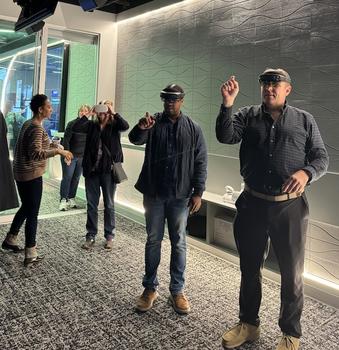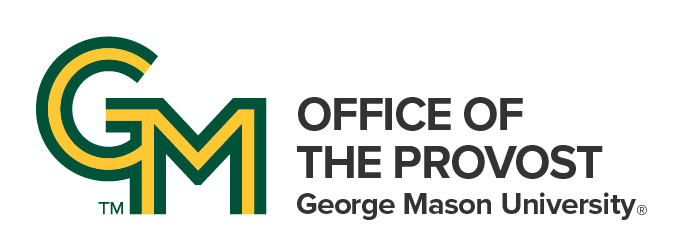The oft-heard phrase “you had to be there” could disappear as the growth of virtual reality (VR) allows individuals to experience the world without ever leaving home. While the pandemic ushered in the era of Zoom classes and meetings—providing the opportunity to participate in classes or meetings with others in different locations—it is VR that creates tangible experiences where people in the same room or thousands of miles away can successfully collaborate.

With the opening of the new Visualization and Virtual Reality Lab in Research Hall—hosted by the Mason Innovation Exchange (MIX) and made possible with funds from the Tech Talent Investment Program—George Mason University has the opportunity to be part of this global movement and to be a leader in transdisciplinary research.
A ‘Cradle’ for Collaboration
The highly anticipated lab, which has been years in the making and serves as the hub of data analysis, visualization, and technology-enabled pedagogy for the university, provides countless opportunities for faculty to combine and advance their interests in new ways. It is also the ideal space to hold demonstrations for sponsoring agencies and partners.
Craig Yu, associate professor of Department of Computer Science, sees the lab as a “cradle for setting up interdisciplinary collaborations” that he believes will enhance the research synergy at George Mason. His current work on a simulated construction site set in the future has brought together researchers from the College of Education and Human Development and the College of Engineering and Computing.
In the lab, users have access to five virtual reality pods within two rooms. The smaller of the rooms has two display screens that connect with high-quality headsets, while the larger room has a 24-foot-long, 9-foot-tall screen that is touch activated—allowing users to manipulate and move data.
Once users are inside this VR or augmented reality (AR), they can experience their surroundings and even “feel objects and be part of accidents or disasters without experiencing pain,” Yu said.
Visualizing and Communicating Complex Ideas

The lab is also ideal for capturing complex ideas that are difficult to understand if one doesn’t visualize them, Yu said.
In Yu’s simulated construction site, performances are tracked and replayed, allowing researchers to see exactly how people work together and respond to situations. Researchers then analyze user performance using scientific metrics, which can help individuals improve over time through repeated exercises.
“Training through VR/AR is helpful to conduct experiments because we can track performance through state-of-the-art technology and give feedback,” said Yu. “These experiments not only enhance user performance, they can also validate if investments [in training] are effective.”
A major component of George Mason researcher Dave Lattanzi’s research involves the generation and analysis of complex, large-scale 3D virtual model data, which he said is difficult to visualize and communicate.
It requires specialized computing and graphics technologies that are challenging to operate on typical computer hardware, making visualization “fundamental to navigating and assessing 3D data,” said Lattanzi, an associate professor in the Sid and Reva Dewberry Department of Civil, Environmental, and Infrastructure Engineering.
The lab will support communications across project teams like Lattanzi’s by providing a shared space for visualization, as well as providing a place for teams to demonstrate their capabilities or findings to sponsoring agencies and university partners, which can lead to additional collaborations and funding opportunities.
VR and Training
Computer science PhD student Liuchuan Yu, a self-described VR/AR addict who is part of the team working on the simulated construction site project, sees creating simulations as a cost-effective and safe way to train individuals in a variety of jobs.
“I am very glad to have this opportunity because it is giving me the necessary experience to create training applications using VR,” he said. “Real-world training is expensive while VR is technically low-cost. Simulations also allow total control of the environment, which is much safer. But they do create awareness and [generate] real responses from the users.”
While use of the lab is restricted to faculty during the 2024-25 academic year, administrators are already thinking about how to incorporate student instruction and student access to modern geospatial technology applications that are difficult, if not impossible, to demonstrate in a traditional classroom environment. Eventually students with ideas for new technologies, applications, or products will be able to use the lab to work on their own projects.
The lab, located in Research Hall, Room 369, is open from 9 a.m. to 5 p.m., Monday through Friday, and can be reserved through 25 Live. All faculty are welcome to reserve and use the lab for research purposes, but must receive training prior to lab use. Contact MIX manager Max Kazemzadeh at mkazemza@gmu.edu, MIX operations coordinator Minjin Batzorig at mbatzor@gmu.edu, or visit the MIX website for more information.
